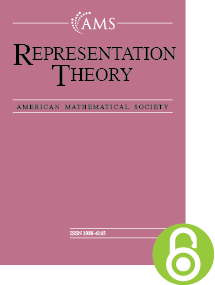On homomorphisms between global Weyl modules
HTML articles powered by AMS MathViewer
- by Matthew Bennett, Vyjayanthi Chari, Jacob Greenstein and Nathan Manning
- Represent. Theory 15 (2011), 733-752
- DOI: https://doi.org/10.1090/S1088-4165-2011-00407-6
- Published electronically: December 20, 2011
- PDF | Request permission
Abstract:
Let $\mathfrak g$ be a simple finite-dimensional Lie algebra and let $A$ be a commutative associative algebra with unity. Global Weyl modules for the generalized loop algebra $\mathfrak g\otimes A$ were defined by Chari and Pressley (2001) and Feigin and Loktev (2004) for any dominant integral weight $\lambda$ of $\mathfrak g$ by generators and relations and further studied by Chari, Fourier, and Khandai (2010). They are expected to play a role similar to that of Verma modules in the study of categories of representations of $\mathfrak g\otimes A$. One of the fundamental properties of Verma modules is that the space of morphisms between two Verma modules is either zero or one-dimensional and also that any non-zero morphism is injective. The aim of this paper is to establish an analogue of this property for global Weyl modules. This is done under certain restrictions on $\mathfrak g$, $\lambda$ and $A$. A crucial tool is the construction of fundamental global Weyl modules in terms of fundamental local Weyl modules.References
- Jonathan Beck and Hiraku Nakajima, Crystal bases and two-sided cells of quantum affine algebras, Duke Math. J. 123 (2004), no. 2, 335–402. MR 2066942, DOI 10.1215/S0012-7094-04-12325-2X
- Vyjayanthi Chari and David Hernandez, Beyond Kirillov-Reshetikhin modules, Quantum affine algebras, extended affine Lie algebras, and their applications, Contemp. Math., vol. 506, Amer. Math. Soc., Providence, RI, 2010, pp. 49–81. MR 2642561, DOI 10.1090/conm/506/09935
- Vyjayanthi Chari, Ghislain Fourier, and Tanusree Khandai, A categorical approach to Weyl modules, Transform. Groups 15 (2010), no. 3, 517–549. MR 2718936, DOI 10.1007/s00031-010-9090-9
- Vyjayanthi Chari and Sergei Loktev, Weyl, Demazure and fusion modules for the current algebra of $\mathfrak {s}\mathfrak {l}_{r+1}$, Adv. Math. 207 (2006), no. 2, 928–960. MR 2271991, DOI 10.1016/j.aim.2006.01.012
- Vyjayanthi Chari and Andrew Pressley, Weyl modules for classical and quantum affine algebras, Represent. Theory 5 (2001), 191–223. MR 1850556, DOI 10.1090/S1088-4165-01-00115-7
- B. Feigin and S. Loktev, Multi-dimensional Weyl modules and symmetric functions, Comm. Math. Phys. 251 (2004), no. 3, 427–445. MR 2102326, DOI 10.1007/s00220-004-1166-8
- G. Fourier and P. Littelmann, Weyl modules, Demazure modules, KR-modules, crystals, fusion products and limit constructions, Adv. Math. 211 (2007), no. 2, 566–593. MR 2323538, DOI 10.1016/j.aim.2006.09.002
- G. Hatayama, A. Kuniba, M. Okado, T. Takagi, and Y. Yamada, Remarks on fermionic formula, Recent developments in quantum affine algebras and related topics (Raleigh, NC, 1998) Contemp. Math., vol. 248, Amer. Math. Soc., Providence, RI, 1999, pp. 243–291. MR 1745263, DOI 10.1090/conm/248/03826
- Masaki Kashiwara, On level-zero representations of quantized affine algebras, Duke Math. J. 112 (2002), no. 1, 117–175. MR 1890649, DOI 10.1215/S0012-9074-02-11214-9
- Michael Kleber, Combinatorial structure of finite-dimensional representations of Yangians: the simply-laced case, Internat. Math. Res. Notices 4 (1997), 187–201. MR 1436775, DOI 10.1155/S1073792897000135
- Hiraku Nakajima, Quiver varieties and finite-dimensional representations of quantum affine algebras, J. Amer. Math. Soc. 14 (2001), no. 1, 145–238. MR 1808477, DOI 10.1090/S0894-0347-00-00353-2
Bibliographic Information
- Matthew Bennett
- Affiliation: Department of Mathematics, University of California, Riverside, California 92521
- Email: mbenn002@math.ucr.edu
- Vyjayanthi Chari
- Affiliation: Department of Mathematics, University of California, Riverside, California 92521
- Email: vyjayanthi.chari@ucr.edu
- Jacob Greenstein
- Affiliation: Department of Mathematics, University of California, Riverside, California 92521
- Email: jacob.greenstein@ucr.edu
- Nathan Manning
- Affiliation: Department of Mathematics, University of California, Riverside, California 92521
- Email: nmanning@math.ucr.edu
- Received by editor(s): December 2, 2010
- Received by editor(s) in revised form: March 9, 2011
- Published electronically: December 20, 2011
- Additional Notes: The second and third authors were partially supported by DMS-0901253 (V.C.) and DMS-0654421 (J.G.)
- © Copyright 2011
American Mathematical Society
The copyright for this article reverts to public domain 28 years after publication. - Journal: Represent. Theory 15 (2011), 733-752
- MSC (2010): Primary 17B10, 17B37
- DOI: https://doi.org/10.1090/S1088-4165-2011-00407-6
- MathSciNet review: 2869017


